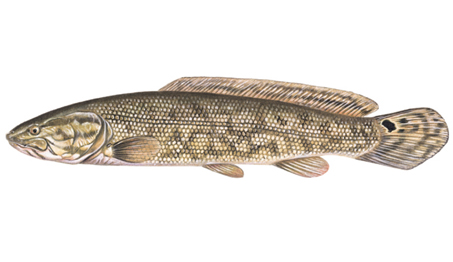The bowfin has a deep body shape. The most distinguishing feature of the bowfin is the hard bony plate on the underside of the jaw. Also, note the distinctive spot, twice the size of the eye, near the tail; the dorsal fin runs almost the length of the fish.
Common Names: bowfin, freshwater dogfish, mudfish, grindle
Habitat
The range is limited to the Great Lakes down stream of the St. Joseph Channel of Lake Superior, the St. Lawrence River and Lakes Nipissing and Simcoe. Bowfins are found in swampy, vegetated bays of lakes and rivers. They have an unusual ability to gulp air from the surface, which enables them to live in areas otherwise inhabitable by other gamefish.
Spawning Patterns
Spawning occurs in the spring. Nests are usually built in depths between 1-2 feet in and around stumps, logs and other vegetation. Spawning occurs in brief periods and the females travel between several different nests. A five-pound female can produce up to 60,000 eggs. Eggs hatch in less than two weeks but the fry remain in large schools that are protected by the male for several weeks.
Age and Size
The maximum age has been suggested at fifteen years but other sources suggest ages as high as thirty. By the age of two, the bowfin can be 30 cm (12”) in length. At age five the fish can be anywhere from three to seven pounds and between 50-65 cm (20-25 inches). The bowfin’s average size is between 45-60 cm (18-24 inches) weighing around three pounds.
Fishing Tips
Bowfin readily hit live bait and lures fished on the bottom in shallow weedy bays.
Fish illustration ©CURTIS ATWATER (www.natureartists.com/atwaterc.htm)









